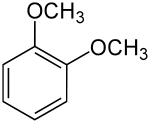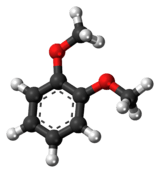1,2-Dimethoxybenzene
1,2-Dimethoxybenzene, commonly known as veratrole, is an organic compound with the formula C6H4(OCH3)2. It is one of three isomers of dimethoxybenzene. It is a colorless liquid, with a pleasant odor and slight solubility in water. It is the dimethyl ether derived from pyrocatechol.
 | |
 | |
| Names | |
|---|---|
| Preferred IUPAC name
1,2-Dimethoxybenzene[1] | |
| Other names
Veratrole o-Dimethoxybenzene Pyrocatechol dimethyl ether | |
| Identifiers | |
3D model (JSmol) |
|
| ChEBI | |
| ChEMBL | |
| ChemSpider | |
| ECHA InfoCard | 100.001.860 |
| EC Number |
|
PubChem CID |
|
| UNII | |
CompTox Dashboard (EPA) |
|
| |
| |
| Properties | |
| C8H10O2 | |
| Molar mass | 138.166 g·mol−1 |
| Density | 1.084 g/cm3[2] |
| Melting point | 22–23 °C (72–73 °F; 295–296 K) [2] |
| Boiling point | 206–207 °C (403–405 °F; 479–480 K) [2] |
| -87.39·10−6 cm3/mol | |
| Hazards | |
| GHS pictograms |  |
| GHS Signal word | Warning |
GHS hazard statements |
H302 |
| P264, P270, P301+312, P330, P501 | |
| NFPA 704 (fire diamond) | |
Except where otherwise noted, data are given for materials in their standard state (at 25 °C [77 °F], 100 kPa). | |
| Infobox references | |
Occurrence
1,2-Dimethoxybenzene is naturally occurring. Its biosynthesis entails the methylation of guaiacol by guaiacol O-methyltransferase.[3] 1,2-Dimethoxybenzene is an insect attractant.[3] Guaiacol O-methyltransferase gene is first scent gene discovered so far in any plant species.[3]
Uses
1,2-Dimethoxybenzene is a building block for the organic synthesis of other aromatic compounds. Veratrole is relatively electron-rich and thus readily undergoes electrophilic substitution.[4]
An example of the use of veratrole is in the synthesis of Domipizone.[5]
Veratrole can easily be brominated with NBS to give 4-bromoveratrole.[6]
Related compounds
- 1,3-Dimethoxybenzene
- 1,4-Dimethoxybenzene
References
- Nomenclature of Organic Chemistry : IUPAC Recommendations and Preferred Names 2013 (Blue Book). Cambridge: The Royal Society of Chemistry. 2014. p. 702. doi:10.1039/9781849733069-00648. ISBN 978-0-85404-182-4.
- Merck Index, 11th Edition, 9857
- Gupta, Alok K; Akhtar, Tariq A; Widmer, Alex; Pichersky, Eran; Schiestl, Florian P (2012). "Identification of white campion (Silene latifolia) guaiacol O-methyltransferase involved in the biosynthesis of veratrole, a key volatile for pollinator attraction". BMC Plant Biology. 12: 158. doi:10.1186/1471-2229-12-158. PMC 3492160. PMID 22937972.
- Janssen, D. E.; Wilson, C. V. (1963). "4-Iodoveratrole". Organic Syntheses.; Collective Volume, 4, p. 547
- EP 0129791, (1985); CA, 102, 220886 (synth, pharmacol).
- Bannard, R. A. B.; Latremouille, G. (1953). "4-BROMOVERATROLE". Canadian Journal of Chemistry. 31 (4): 469–469. doi:10.1139/v53-062. ISSN 0008-4042.
